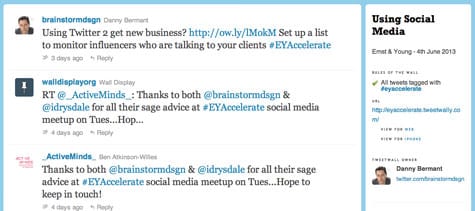In order to run a successful social media campaign, your offline activity matters as much as your online activity.
Whilst businesses find it relatively easy to set up social media channels, they struggle with the next step, attracting followers. And it’s not just small businesses that find it a challenge. Even major brand names have Facebook and Twitter pages that struggle to get their fan numbers beyond double figures! In this, the first in a series of posts, I'll explain some practical approaches to gain more interaction on you social channels.
If you want to understand the difference between those who attract fans and those who don’t, take a quick look around you next time you travel to the shops. Look at the number of advertising billboards that include social media references. Then look at the packaging of some of the products you buy and there’s your answer. Many businesses forget to integrate social media into their existing offline marketing and result is that customers simply don’t know about them.
Before you embark on a social media campaign, you need to ensure your offline marketing is an integral part of that campaign.
The first step is ensure your social media references are simple, memorable and easy to pronounce e.g. on radio and TV. There will usually be a time lag between a customer seeing a reference to your social media channel on an ad and then acting on it. By simplifying addresses, they are more likely to remember. For example, when I was working with the IDM recently at an event to promote courses I run we used these simple offline signposts:
 The next step is to create an audit of all your offline marketing in order to ensure your social media presence is ubiquitous:
The next step is to create an audit of all your offline marketing in order to ensure your social media presence is ubiquitous:
- Printed material: business cards, compliment slips, letterheads, invoices
- Advertising material: Pull up banners, posters and stands that are used at trade events
- Product packaging as well as point of sale material
- Broadcast material: TV advertising and radio
When adding social media identities to your print material, don’t go overboard. Rather than share every single channel, focus on the one most relevant to your target audience. Ideally, you should even avoid references to Facebook or Twitter and just use logos. The simpler the reference, the more impact it has. The same applies to all other forms of advertising.

Here a hashtag painted on the grass of a football field. You don’t even need to see the twitter logo. The hashtag gives it away.
Think outside the box
So far we’ve covered the obvious places where you need to mention your social media channels. But you can also be creative. Think about all the places where you interact offline with customers and how you can attract their attention. Here are a couple of other examples to give you inspiration:
Have a Twitter wall at your live customer event: Twitter walls are low maintenance, low cost way to publicise your social media channels. All you need is a large screen and a trending hashtag around your event. The screen both encourages delegates to interact as well as publicising your online presence in the process. The interaction will continue long after the event is over. You can also use Twitter walls in other scenarios e.g. Restaurants. When patrons see other customers orders appearing on a twitter screen, they will want to use the service too.

If you have a store, use digital displays to highlight the products your audience are talking about: C&A Brazil embedded Facebook likes into their clothes hangars. Whenever someone 'Likes' a piece of clothing on C&A Brazil’s online store, the Facebook thumbs-up is then tallied on a screen embedded in clothes hangers on the shop’s physical racks.

Whilst it’s clear your offline channels will help promote your social media activity, the main benefit is that you’ll make your customer experience more interactive, easier and ultimately more fun in the process!
In the article I'll look at how to integrate your offline social campaigns by ensuring customer facing staff are briefed on your social media activity.










